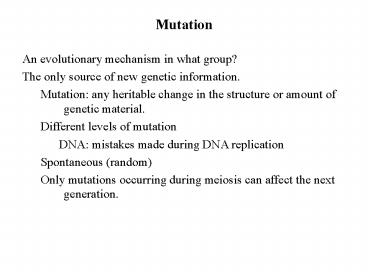Mutation - PowerPoint PPT Presentation
1 / 9
Title:
Mutation
Description:
Hardy-Weinberg equilibrium formula. Allele frequencies 0.5 G; 0.5 g. Genotype frequencies ... Then plug the frequencies into the Hardy-Weinberg formula ... – PowerPoint PPT presentation
Number of Views:106
Avg rating:3.0/5.0
Title: Mutation
1
Mutation
- An evolutionary mechanism in what group?
- The only source of new genetic information.
- Mutation any heritable change in the structure
or amount of genetic material. - Different levels of mutation
- DNA mistakes made during DNA replication
- Spontaneous (random)
- Only mutations occurring during meiosis can
affect the next generation.
2
(No Transcript)
3
(No Transcript)
4
Effects of a mutation Depends on how it affects
the functioning of the protein.
5
Population genetics
- Is evolution taking place in a population?
- Evidence
- 1. Statistical analysis of phenotypic attributes
- 2. Change in allele frequencies.
6
Human controlled crosses
One gene two alleles Probability of getting
particular genotypes Based on frequencies of
alleles Same cross can be depicted as (G g) x
(G g) (G g)2 G2 2Gg g2 Generalized
case (p q)2 p2 2pq q2 Hardy-Weinberg
equilibrium formula Allele frequencies ? 0.5 G
0.5 g Genotype frequencies ? Phenotype
frequencies So evolution can be defined as a
change in allele frequencies.
7
In natural populations
- Alleles segregate into different games in the
same way, but - Individuals free to choose mates
- Genotypic and phenotypic frequencies dependent on
allele frequencies.
8
Information from individuals in Lab Section 2,
with no individuals added from Regis
population. . Hand clasping 15 dominant (L on R)
3 recessive (R on L) N 18 15/18 individuals
are either C/C or C/c 0.83 3/18 individuals ARE
c/c 0.17 Is the population sampled in genetic
equilibrium? Need to know the frequencies of C
and c. Then plug the frequencies into the
Hardy-Weinberg formula Represents one generation
of random mating q2 frequency of c/c 0.17 q
square root of q2 square root of 0.17
0.4123 P q 1 p 1 q 1 0.4123
0.5877 p2 2pq q2 1 (0.5877)2
2(0.5877)(0.4123) (0.4123)2 0.3454 0.4846
0.1700 1 P 0.3454 ½(0.4846) 0.5877 q
0.1700 ½ (0.4846) 0.4123
Observed p and q
Have frequencies of C and c changed after
one generation of random mating.
Expected p and q
9
Try this problem
- Information from students in Lab Section 2.
- Free ear lobes 13 individuals
- Attached ear lobes 5 individuals
- Is the population, from which this sample was
drawn, in genetic equilibrium? - If so,
- Is one condition more advantageous than the
other? - Hypothesis?































